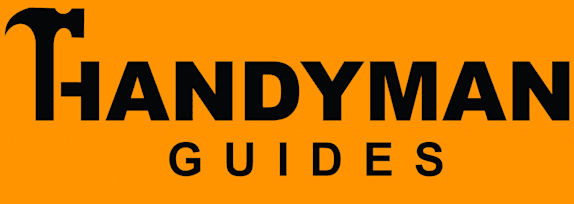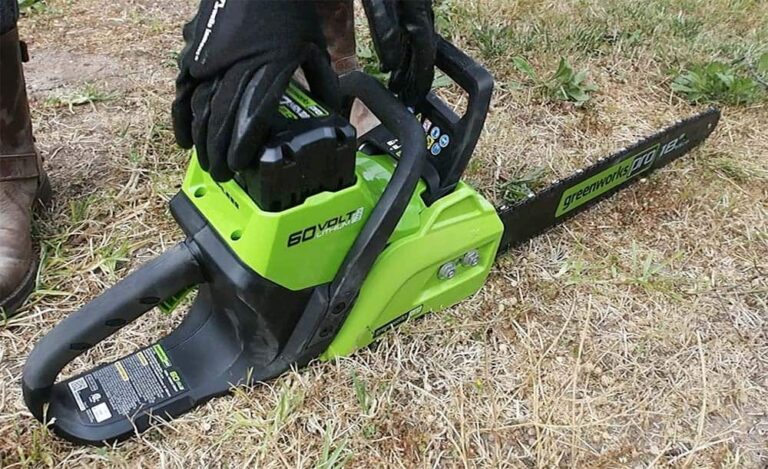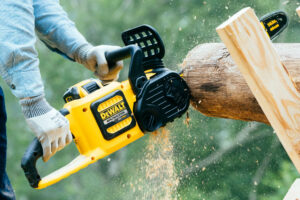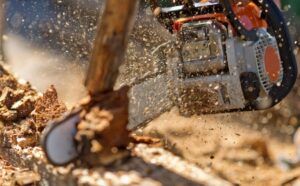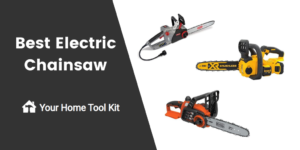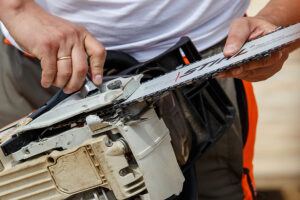If you are looking for a way to cut trees without gas, consider purchasing an electric chainsaw. Electric chainsaws have many benefits over gas-powered saws, including safety, lubrication, and easy start-up. This article will provide you with the knowledge you need to know about this tool. It will also explain what you can expect from the chainsaw and how to properly use it. Keep reading for some tips.
Safety
Electric chainsaws have numerous safety features and should always be used with caution. When cutting trees, the saw’s blade applies light pressure to the tree trunk. When using an electric chainsaw, avoid cutting branches that are above shoulder height. This is because a kickback from a chainsaw can be extremely dangerous and could result in a serious injury or even death. Similarly, never cut a tree while using a ladder. The vibration from the chainsaw can unsteady a ladder and it can be difficult to dodge falling branches.
When cutting wood, be sure to inspect the wood thoroughly to avoid kickback. Kickback can occur when the blade nicks a branch or nail. To prevent kickback, it is important to keep the chain sharp and tense. Also, remember to cut from below the shoulder. Using an electric chainsaw requires practice, and you should follow certain precautions to avoid injuries. You should also be aware of the different types of kickbacks that can occur when cutting a tree.
Limitations
Electric chainsaws are a convenient alternative to gas-powered saws, but they have some limitations. Because they don’t use gas, electric saws have a lower power output and smaller cutter bars, ranging from 8 to 15 inches. These saws are also limited in mobility because the power cord has to be set up before you can use it. The cord also means that you cannot use the saw away from a power source, which makes it unsuitable for work outside of the home.
Electric chainsaws are also limited in cutting power and cannot cut very thick wood. The speed of these tools is also moderate, requiring a bit of extra time to complete a task. In addition to their limitations, battery-powered electric chainsaws have fewer weight and space requirements. They also provide optimal motor performance for about an hour. Therefore, battery-powered chainsaws are an ideal option for those who need to perform intense tasks.
Proper lubrication
While you may be thinking that motor oil is fine for your electric chainsaw, you are mistaken. Bar and chain oil is the only oil you need for electric chain saws. Gas-powered chain saws need a pre-mixed gas and oil to run properly, as well as a bar and chain oil.
There are a few different types of electric chainsaw oil available for purchase. If you plan to use a chainsaw regularly, you should use the specialized oil designed for electric chainsaws. Many manufacturers recommend a specific brand of oil for their chainsaws.
It is a type of synthetic oil that is specifically formulated for lubrication. These types of oils are also environmentally friendly. Using other types of oil, like motor oil, will cause damage to the electric chain saw’s lubrication system. Motor oil is a common substitute, but it has a few drawbacks.
Other than synthetic oils, vegetable oils are another option. Vegetable oils are considered to be the safest, but they have limitations when it comes to cold-temperature performance and oxidation stability. Fortunately, vegetable oil with additives can overcome these limitations. The canola-based oil can give good performance even in colder weather and is also inexpensive.
Safer than gas-powered chainsaws
A chainsaw is considered safer than a gasoline-powered saw if it is electric. Electric chainsaws can be operated by pulling the cord. They are easier to handle and tend to be quieter when in operation. A chainsaw’s chain should be properly tensioned to maximize its performance. A tool-less chain tensioning knob makes this task much easier. Other electric chainsaw models require a screwdriver to adjust the chain tension.
Properly maintained chainsaws help minimize kickback, which can cause injuries or even death. Properly oiled chains last longer. Using protective gear is highly recommended. Properly fitting earplugs and muffs can protect the operator from excessive noise. Using protective gear can also protect the operator’s head, eye, and thigh from injuries. Chainsaws should be kept well away from people, including foreign objects while operating.
Proper bar length
You need to choose the right bar length when using an electric chainsaw. The bar length of a chainsaw is determined by its engine size. A longer chain requires more power, and therefore a larger engine. This makes the saw heavier, and the vibration will increase the user’s fatigue, increasing the chance of an accident. A shorter bar allows for a smaller engine and thus less vibration. To choose the right bar length for your project, first measure the material you’ll be cutting.
A chainsaw bar’s true length can be determined by counting the number of small bumps that appear along its inside surface. The gauge of drive links should match the chainsaw bar’s gauge. You can measure this with a caliper or an inexpensive multi-purpose gauge. You must have a true bar length for safe chainsaw use. This is essential to avoid injuries and abrasions while cutting wood or other objects.
Avoiding kickback
If you’ve ever used a chainsaw, you’ve probably encountered a situation known as “kickback.” This is a sudden upward movement of the saw’s guide bar that occurs when the saw is in use. Kickback can occur with either gas or electric chainsaws and is dangerous. Luckily, most cases of kickback are completely avoidable. While many situations aren’t violent, they can still be dangerous, and all chainsaw users need to be aware of them.
A common cause of chainsaw injuries is operator error and a lack of proper judgment about safety. Many accidents occur when a person is unaware of kickback, and fail to protect themselves. When kickback occurs, the chain of the saw follows its path of cutting, and the moving saw can come in contact with the operator’s body. This zone of impact is typically made up of the upper half of the body, making it a prime target for injury.
Jake is a tool guy – think Tim Allen from Home Improvement but with a much drier sense of humor. He lives in the great state of Ohio and plays the guitar on his downtime. He also spends his time writing on all things tools and DIY-related as this is his passion.
